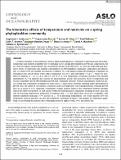The interactive effects of temperature and nutrients on a spring phytoplankton community
Author(s)
Anderson, Stephanie I.; Franzè, Gayantonia; Kling, Joshua D.; Wilburn, Paul; Kremer, Colin T.; Menden‐Deuer, Susanne; Litchman, Elena; Hutchins, David A.; Rynearson, Tatiana A.; ... Show more Show less
DownloadLimnology Oceanography - 2022 - Anderson - The interactive effects of temperature and nutrients on a spring phytoplankton (1).pdf (1.020Mb)
Publisher with Creative Commons License
Publisher with Creative Commons License
Creative Commons Attribution
Terms of use
Metadata
Show full item recordAbstract
A complex interplay of environmental variables impacts phytoplankton community composition and physiology.
Temperature and nutrient availability are two principal factors driving phytoplankton growth and composition, but
are often investigated independently and on individual species in the laboratory. To assess the individual and interactive effects of temperature and nutrient concentration on phytoplankton community composition and physiology, we altered both the thermal and nutrient conditions of a cold-adapted spring phytoplankton community in
Narragansett Bay, Rhode Island, when surface temperature was 2.6 C and chlorophyll > 9 μg L1
. Water was incubated in triplicate at 0.5 C, 2.6 C, and 6 C for 10 d. At each temperature, treatments included both nutrient
amendments (N, P, Si addition) and controls (no macronutrients added). The interactive effects of temperature and
resource availability altered phytoplankton growth and community structure. Nutrient amendments resulted in species sorting and communities dominated by larger species. Under replete nutrients, warming tripled phytoplankton
growth rates, but under in situ nutrient conditions, increased temperature acted antagonistically, reducing growth
rates by as much as 33%, suggesting communities became nutrient limited. The temperature–nutrient interplay
shifted the relative proportions of each species within the phytoplankton community, resulting in more silica rich
cells at decreasing temperatures, irrespective of nutrients, and C : N that varied based on resource availability, with
nutrient limitation inducing a 47% increase in C : N at increasing temperatures. Our results illustrate how the
temperature–nutrient interplay can alter phytoplankton community dynamics, with changes in temperature amplifying or exacerbating the nutrient effect with implications for higher trophic levels and carbon flux.
Date issued
2022-02-08Department
Massachusetts Institute of Technology. Department of Earth, Atmospheric, and Planetary SciencesPublisher
Wiley
Citation
Anderson, Stephanie I., Franzè, Gayantonia, Kling, Joshua D., Wilburn, Paul, Kremer, Colin T. et al. 2022. "The interactive effects of temperature and nutrients on a spring phytoplankton community." 67 (3).
Version: Final published version
ISSN
0024-3590
1939-5590